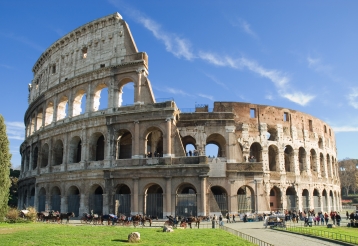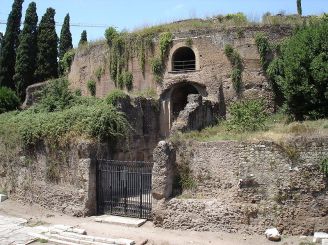Pantheon, Rome
One of the symbolic monuments of Rome – the Pantheon – is located on Piazza della Rotonda. The monument was built in 126 by Emperor Adrian.
History of the Pantheon
Earlier, on the place where the Pantheon is situated nowadays, was a temple built in the year of 27 BC by commander Marcus Vipsanius Agrippa, as the inscription on the pediment of the building says. The architect Apollodorus of Damascus supervised construction work.
In the 7th century, the pagan Pantheon became Christian. It was donated by the Byzantine Emperor Nicephorus II Phocas to Pope Boniface IV. In 609, Pope issued a decree and renamed the Pantheon in the Church of Our Lady of Martyrs, which allowed monument to survive till the present day, while many ancient monuments were destroyed.
In the 14–15 centuries, the Roman Pantheon was used as a defensive structure, and only during the Renaissance it was rebuilt. Raphael Santi led the restoration works at the temple, where he was buried in 1520. Pantheon served as the burial place of the royal dynasty.
In the 17th century, an Italian architect Giovanni Bernini created what the next two centuries the locals called "donkey ears of Bernini" – he overbuilt two small bell towers. Later, they were removed.

Today the Pantheon in Rome is a symbol and landmark of the city, which attracts many tourists. During holidays worships are held there.
Interesting facts
- Pantheon is a symbol of power and architectural magic. Lack of windows makes it unusual. The only source of natural light is a dome – Oculus, 9.1 m of diameter. It was designed so that when the sunlight enters the temple, it illuminates the statues of ancient gods one by one.
- Oculus has a lot of legends to tell. According to one of them, during the construction of the Pantheon, dome was intact. During the first church-office, the evil spirits broke through and made a hole in the top of the dome. This hole really gives to the construction a mysterious look. Light, falling through the Oculus, produces magical paintings on the walls. During snowfalls snowflakes occasionally descend just inside the Pantheon.
- The Pantheon is a place where tombs of King Umberto I and Victor Emmanuel II are located. It is also a burial place of Raphael, an Italian painter of the 15th century.
- From the Greek πάνθειον, Pantheon means "Temple of all the Gods".
- Until the 19 century, the Pantheon temple had the title of the world's largest dome.
The inner part of the Temple of the Gods
Inside, the temple is decorated with colored marble. Visitors enter the Pantheon through the ancient bronze gates, 7 m high. The transformation of the ancient temple into the Christian one allowed to keep many elements of the architecture in its original form.
Further, through the lobby, you will be in a massive portico with columns. Their base is made of red granite brought from Egypt, and the capitals and bases – from Greek marble. The walls are divided by niches, where the paintings of famous artists are placed nowadays.
While the outside of the Pantheon impresses with its strength and power, inside the temple you will feel calmness and a sense of the universal acceptance of the outside world. The dimensions of the temple are designed so that its height corresponds to the diameter of the rotunda, and if you continue the dome to the ground – it turns to a globe. Ancient architects believed, the globe is a symbol of harmony of the universe.
How to get
The nearest metro station is Largo di Torre Argentina. You can get from Spain Square to the street of Via del Corso on foot.
Open time: 9:00 am to 6:00 pm. Entrance to the Pantheon is free.




